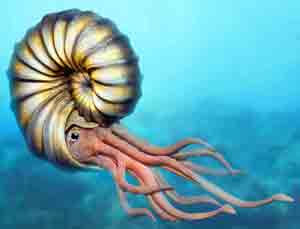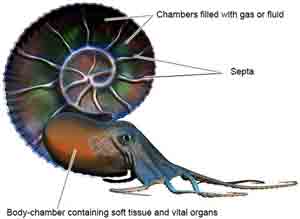 This form was one of the most typical of the Upper Cretaceous ammonites, with an unusually thick shell with rich ornaments.
This form was one of the most typical of the Upper Cretaceous ammonites, with an unusually thick shell with rich ornaments.
The section of the shell was vaguely square and the last lap was not very high. The
ribs were thick but simple, straight and thick, with rounded tubercles, the sides and near the sifonal edge. No one knows with certainty what was the result of this coastal development, it seems however, that the shells were thick and ornamented ammonites characteristic of the last note. Among other kinds of Acantoceratinae, remember
Mantelliceras.
Acanthoceras was a warning of average size, which easily reach the shell diameter of about ten centimeters.
The
Ammonites are an extinct group of Cephalopods, which appeared in the Lower Devonian about 400 million years ago and extinguished at the end of the Cretaceous, together with the Dinosaurs (65 million years ago), leaving no known descendants.

Like all cephalopods known this organisms were carnivorous: active predators of marine animals, microphagous (plankton), scavengers, and even cannibals. The shell of ammonites in general has the form of a
spiral wound on a plan (although some species, such
heteromorphy, have a more complex three-dimensional winding) and it is this feature that has given their name. The appearance infact resembles a
coiled horn, like that of a ram (the Egyptian god
Amon was commonly depicted as a man with ram's horns). Pliny the Elder described the fossils of these animals ammonis cornua, "horns of Ammon." Often the name of the species of Ammonites ends with -ceras, from a greek word (κÎρας) whose meaning is, in fact,
"horn" (eg. Pleuroceras etymologically means horn with the coast).
The shell was divided by
septa into several rooms, including the clam occupied only the last. The others were used as
"air chambers" filled with gas and liquid to control the
floating body. The ammonite could well change its depth in a manner similar to the current
Nautilus.
Because of their extraordinary variability and distribution in marine sediments around the world the ammonites are considered fossils for excellence and
guide-fossils of exceptional value, used for dating in stratigraphy of the sedimentary rocks.
The classification of ammonites is made on the basis of morphology and
ornamentation of the shell, and the shape of septa, depending on the
suture line.



